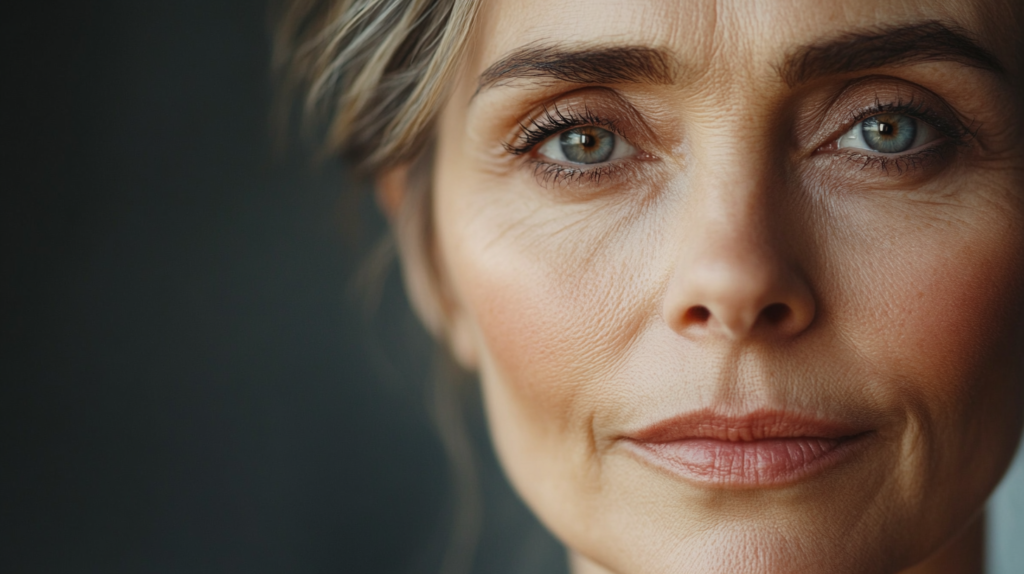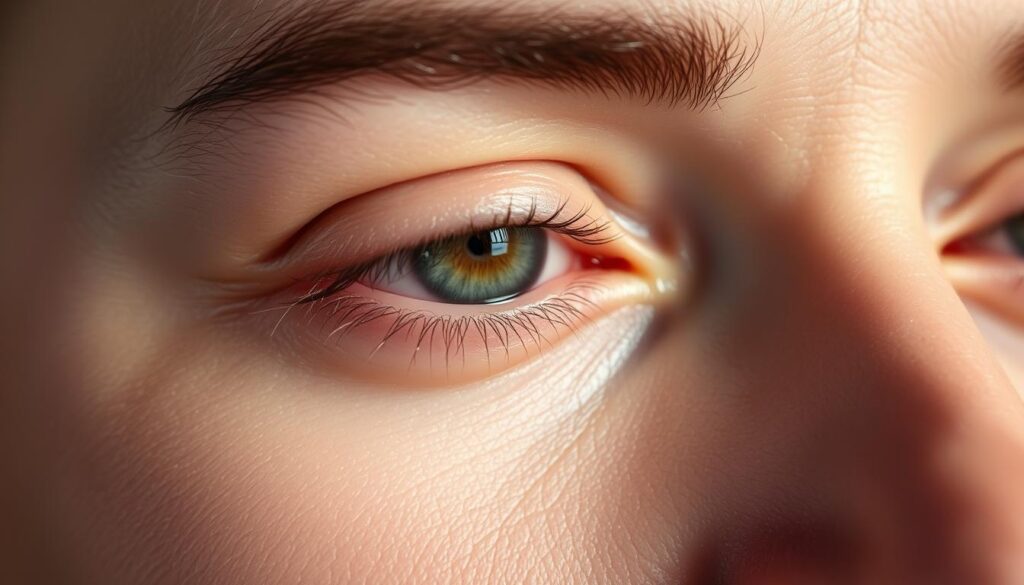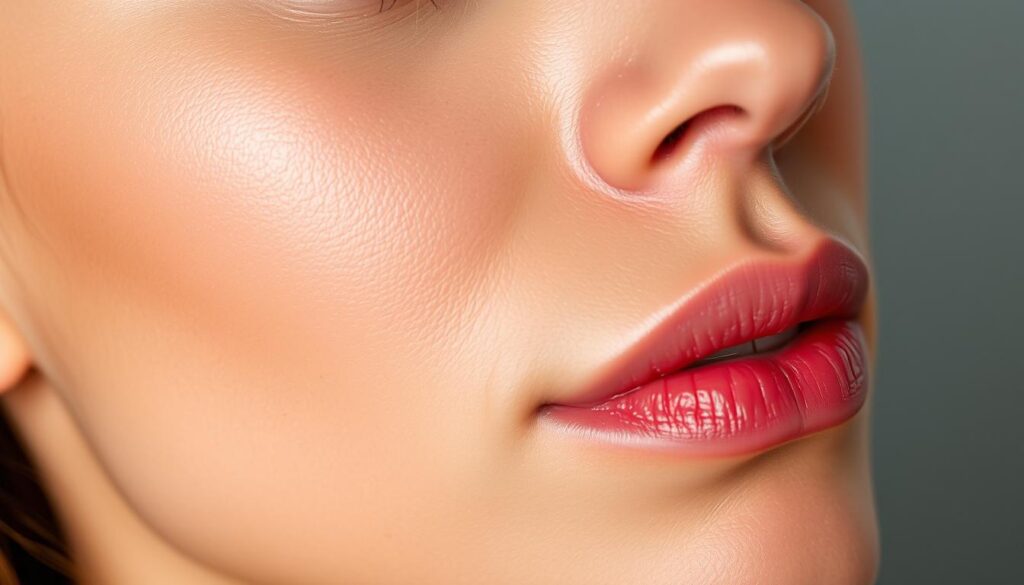Have you ever noticed shadows or discoloration beneath your eyes? These are often referred to as dark circles, and they can affect your appearance and confidence. While they are usually a cosmetic concern, understanding their causes can help you find the right solutions.
Several factors contribute to their appearance. Genetics, lifestyle habits like smoking or stress, and even underlying conditions such as eczema can play a role. For example, studies show that about 20% of individuals with this issue may have an underlying medical condition1.
In this article, we’ll explore both home remedies and medical treatments. From understanding how blood vessel visibility affects the skin to discovering effective fixes, you’ll find practical steps to improve your under-eye area. Let’s dive in and help you achieve a refreshed look!
Understanding the Anatomy of the Eye Area
The delicate area around your eyes is more complex than you might think. This region has a unique structure that makes it prone to discoloration and shadows. Let’s break down the key components to understand why these issues occur.
Skin, Blood Vessels, and Fat Distribution
The skin under your eyes is thinner than the rest of your face. This thinness makes blood vessels more visible, contributing to a darker appearance. Additionally, the clustering of blood vessels in this area can intensify the issue2.
Fat distribution also plays a role. As you age, the fat pads beneath your eyes can shift or shrink, creating hollows that cast shadows. This process, combined with the thin skin, makes the area more susceptible to discoloration3.
The Role of Genetics and Aging
Genetics can influence how prominent your under-eye area appears. If your family has a history of this concern, you’re more likely to experience it too2. Aging further exacerbates the issue, as collagen production decreases and skin loses elasticity.
Smoking and allergies can also worsen the appearance. Smoking accelerates collagen loss, while allergies cause inflammation and swelling, making the area look darker3.
| Factor | Impact |
|---|---|
| Thin Skin | Makes blood vessels more visible |
| Fat Distribution | Creates shadows as it shifts with age |
| Genetics | Predisposes you to darker under-eye areas |
| Aging | Reduces collagen and skin elasticity |
Understanding these factors helps explain why certain treatments work. For example, addressing blood flow or boosting collagen can improve the area’s appearance. Now that you know the anatomy, let’s explore the causes in the next section.
Dark Circles Under Eyes: Causes and Fixes
Have you ever wondered why some people seem more prone to shadows beneath their eyes? This common concern can stem from various factors, including lifestyle habits and nutritional deficiencies. Understanding these causes is the first step to finding effective solutions.
One major contributor is sleep deprivation. When you don’t get enough rest, your blood vessels widen, making them more visible under the thin skin of your under-eye area. Studies show that sleep deprivation can increase the appearance of these shadows by 20%4.
Nutrition also plays a key role. A lack of essential vitamins, such as B12 and K, can lead to skin discoloration. For example, low levels of vitamin B12 have been linked to increased pigmentation5. Incorporating nutrient-rich foods into your diet can help maintain healthy skin around your eyes.
Individual differences also matter. Every person may respond differently to treatments based on genetics and lifestyle. For instance, about 30% of individuals with this issue have a family history of it4. This means what works for one person might not work for another.
Improving your daily habits can make a significant difference. Here’s a quick overview of key factors:
| Factor | Impact |
|---|---|
| Sleep Deprivation | Widens blood vessels, increasing visibility |
| Vitamin Deficiency | Leads to skin discoloration and dullness |
| Genetics | Influences susceptibility to shadows |
| Hydration | Keeps skin plump and reduces dullness |
By addressing these factors, you can take steps to get rid of unsightly shadows. Later sections will explore home remedies and medical treatments to help you achieve a refreshed look.
Identifying Common Causes
Many factors can lead to shadows or discoloration in the under-eye area. Understanding these causes can help you take steps to improve its appearance. Let’s explore the most common contributors.
Lack of Sleep, Fatigue, and Eye Strain
Insufficient sleep is a major factor. When you don’t rest enough, blood vessels widen, making them more visible under the thin skin of this delicate area6. Chronic fatigue and prolonged eye strain can also worsen the condition, giving the skin a dull and tired look.
Studies show that most adults need 7 to 8 hours of sleep each night to reduce the risk of these issues7. If you’re struggling with sleep, consider adjusting your routine to prioritize rest.
Allergies, Dehydration, and Sun Overexposure
Allergies can cause inflammation and puffiness, making the under-eye area appear darker6. Dehydration is another culprit, as it reduces skin elasticity and leads to a sunken appearance. Drinking enough water daily—about 13 cups for men and 9 cups for women—can help maintain skin health7.
Sun overexposure can lead to hyperpigmentation, especially in this sensitive area. Using a broad-spectrum sunscreen or a specialized cream can protect your skin and prevent further damage8.
As you age, the skin loses collagen and elasticity, making these issues more noticeable. Combining preventive measures with targeted treatments, like hydrating creams, can help improve the overall condition of your under-eye area.
| Factor | Impact |
|---|---|
| Lack of Sleep | Widens blood vessels, increasing visibility |
| Allergies | Causes inflammation and puffiness |
| Dehydration | Reduces skin elasticity, leading to dullness |
| Sun Overexposure | Triggers hyperpigmentation |
These causes may also interact, making it essential to address multiple factors simultaneously. By understanding these contributors, you can take proactive steps to improve the appearance of your under-eye area.
Effective Home Remedies for Dark Circle Eye Treatment
Looking for natural ways to refresh your under-eye area? Simple home remedies can help reduce puffiness, improve circulation, and brighten your appearance. These solutions are easy to implement and can make a noticeable difference.
Cold Compresses and Chilled Tea Bags
Applying a cold compress can shrink blood vessels, reducing puffiness and improving circulation9. Chilled tea bags, especially green or chamomile, are another great option. The caffeine in green tea stimulates blood flow, while chamomile soothes irritation10.

To use, steep two tea bags in hot water, let them cool, and place them in the fridge for 10 minutes. Apply them to your eyes for 15 minutes for a refreshing effect.
Nutrient-Rich Diets and Hydration Tips
A balanced diet plays a key role in skin health. Foods rich in vitamins C and K, like tomatoes and cucumbers, can reduce pigmentation and strengthen capillaries10. Staying hydrated is equally important, as dehydration can make the skin appear dull and sunken10.
Here are some tips to incorporate into your routine:
- Drink at least 8 glasses of water daily.
- Include vitamin-rich foods like leafy greens and citrus fruits.
- Avoid excessive alcohol and caffeine, which can dehydrate the skin9.
While genetics may influence your under-eye area, these remedies can help you manage its appearance effectively. Pair them with a consistent skincare routine for the best results.
Medical Treatment Options to Consider
When home remedies aren’t enough, medical treatments can offer effective solutions. These advanced procedures target the root causes of under-eye concerns, providing long-lasting results. From non-invasive therapies to surgical options, there’s a range of treatments to explore.
Laser Therapy, Chemical Peels, and Fillers
Laser therapy is a popular choice for improving skin texture and reducing hyperpigmentation. It works by targeting the deeper layers of the skin, stimulating collagen production and evening out skin color11. Chemical peels, on the other hand, use acids to exfoliate the top layer of skin, revealing a brighter and smoother surface12.
Fillers are another effective option, especially for addressing volume loss caused by aging. Hyaluronic acid fillers can restore plumpness to the under-eye area, reducing shadows and creating a more youthful appearance11.
Surgical Procedures and Advanced Dermatological Options
For more severe cases, surgical procedures like blepharoplasty can be considered. This surgery removes excess fat and tightens loose skin, addressing both aesthetic and functional concerns11. It’s particularly effective for individuals with deep grooves or puffiness caused by aging or genetics12.
Other advanced options include prescription creams containing ingredients like kojic acid and vitamin K, which have been shown to reduce hyperpigmentation12. These treatments are often combined with lifestyle changes, such as minimizing sun exposure, to enhance results11.
Here’s a quick comparison of these treatments:
| Treatment | Benefits | Risks |
|---|---|---|
| Laser Therapy | Improves skin texture, reduces hyperpigmentation | Temporary redness, swelling |
| Chemical Peels | Brightens skin, evens out color | Skin sensitivity, peeling |
| Fillers | Restores volume, reduces shadows | Bruising, uneven results |
| Blepharoplasty | Long-lasting, addresses multiple factors | Recovery time, surgical risks |
Before choosing a treatment, consult with a certified dermatologist or plastic surgeon. They can evaluate your skin and recommend the best option based on your unique needs. With the right approach, you can achieve a refreshed and rejuvenated look.
Prevention Strategies and Lifestyle Adjustments
Taking proactive steps can help you maintain a bright and refreshed look. By making small changes to your daily routine, you can reduce the risk of shadows and discoloration. Let’s explore practical strategies to keep your under-eye area healthy and vibrant.
Improving Sleep Habits and Stress Management
Getting enough rest is crucial for preventing fatigue-related issues. Most adults need 7 to 9 hours of sleep each night to reduce puffiness and improve skin health13. Establishing a consistent bedtime routine can help you fall asleep faster and stay asleep longer.
Stress can also take a toll on your appearance. Techniques like meditation, deep breathing, or yoga can help you manage stress effectively. Elevating your head while sleeping may prevent fluid accumulation, reducing puffiness13.
Here are some tips to improve your sleep quality:
- Limit screen time before bed to reduce blue light exposure.
- Avoid caffeine and heavy meals close to bedtime.
- Create a calming environment with dim lighting and soothing sounds.
Using Sunscreen and UV Protective Measures
Protecting your skin from the sun is essential for maintaining an even skin color. UV exposure can increase pigment production and make blood vessels more visible14. Apply a broad-spectrum sunscreen with SPF 30 or higher daily, even on cloudy days.
For added protection, wear sunglasses and a wide-brimmed hat when outdoors. These measures shield the delicate skin around your eyes from harmful rays. If you have a family history of skin sensitivity, these steps are even more important.
Here’s how to incorporate sun protection into your routine:
- Choose a lightweight, non-greasy sunscreen for the under-eye area.
- Reapply sunscreen every two hours during prolonged sun exposure.
- Opt for makeup products with built-in SPF for added convenience.
By addressing allergy triggers and making these adjustments, you can minimize the appearance of shadows. Small changes today can lead to long-term improvements in your skin’s health and appearance.
Expert Tips and Best Practices for Daily Care
Your daily routine can make a big difference in how your under-eye area looks. By incorporating expert advice into your skincare regimen, you can improve its appearance and maintain a refreshed look. Let’s explore some practical tips to help you get started.
Choosing the Right Eye Creams
Selecting the right eye cream is crucial for addressing shadows and discoloration. Look for products with ingredients like vitamin K, caffeine, and hyaluronic acid. These components can reduce puffiness, improve circulation, and hydrate the skin15.
For example, creams with caffeine can constrict blood vessels, making the area appear brighter. Meanwhile, hyaluronic acid helps retain moisture, plumping the skin and reducing the sign of hollows16.
Makeup Solutions for a Brighter Look
Makeup can be a game-changer when it comes to concealing shadows. Opt for a concealer one shade lighter than your skin tone to brighten the area. Products with SPF 15 or higher offer added protection against environmental stressors17.
Here’s a quick guide to applying makeup effectively:
- Use a color corrector to neutralize discoloration.
- Apply concealer in a triangular shape for a lifting effect.
- Set with a lightweight powder to prevent creasing.
Hydration and Lifestyle Adjustments
Proper hydration is essential for maintaining healthy skin. Drinking enough water daily can reduce dullness and keep the skin plump. Dehydration can make shadows more noticeable, so aim for at least 8 glasses of water a day16.
Additionally, addressing lack sleep can significantly improve the area’s appearance. Aim for 7 to 9 hours of rest each night to minimize puffiness and fatigue17.
| Tip | Benefit |
|---|---|
| Use caffeine-based creams | Reduces puffiness and brightens skin |
| Apply SPF-infused concealer | Protects and conceals simultaneously |
| Stay hydrated | Keeps skin plump and reduces dullness |
| Prioritize sleep | Minimizes fatigue-related shadows |
By following these expert tips, you can enhance your daily care routine and achieve a brighter, more refreshed appearance. Small changes today can lead to long-term improvements in your skin’s health.
Conclusion
Achieving a refreshed look around eye is possible with the right approach. From lifestyle changes to targeted treatments, addressing the root causes can make a significant difference. Factors like sleep deprivation, dehydration, and UV exposure often contribute to the issue18.
Simple home remedy options, such as cold compresses and caffeine-based creams, can reduce puffiness and improve circulation19. For more persistent concerns, medical treatment like fillers or laser therapy may help restore volume and even out skin tone20.
Experts recommend prioritizing sleep, staying hydrated, and protecting the delicate skin beneath eye from sun damage18. For advanced procedures, consulting a professional ensures tailored solutions for your needs.
With consistent care and the right strategies, you can achieve a brighter, more rested appearance. Start implementing these tips today for a comprehensive approach to under-eye care.



